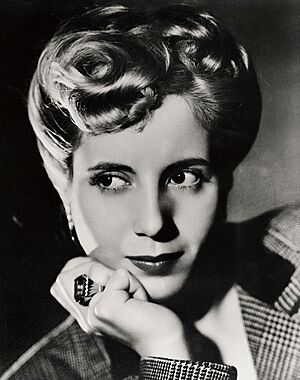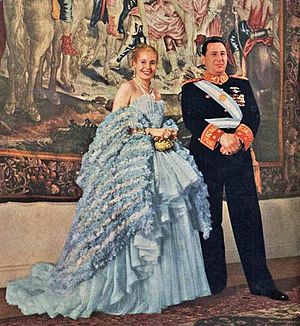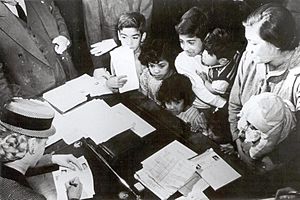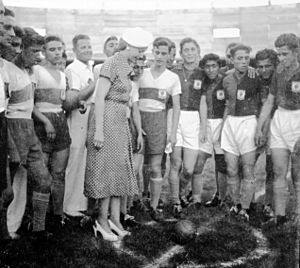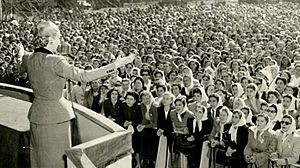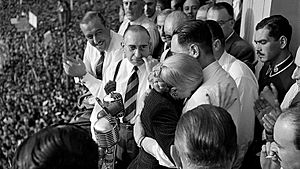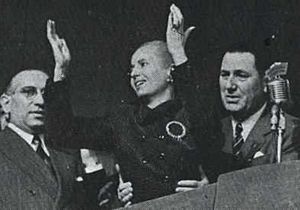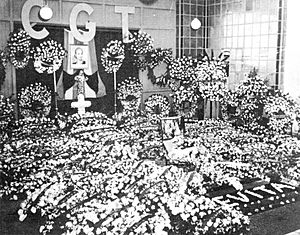Eva Perón facts for kids
Quick facts for kids
Spiritual Leader of the Nation
Eva Duarte Perón
|
|
|---|---|
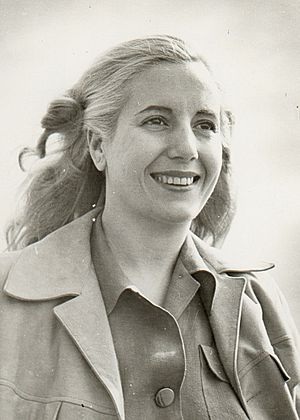
Perón in 1948
|
|
| First Lady of Argentina | |
| In role 4 June 1946 – 26 July 1952 |
|
| President | Juan Domingo Perón |
| Preceded by | Conrada Victoria Farrell |
| Succeeded by | Mercedes Lonardi (1955) |
| President of the Eva Perón Foundation | |
| In office 8 July 1948 – 26 July 1952 |
|
| Preceded by | Position established |
| Succeeded by | Delia Parodi |
| President of the Female Peronist Party | |
| In office 29 July 1949 – 26 July 1952 |
|
| Preceded by | Position established |
| Succeeded by | Delia Parodi |
| Personal details | |
| Born |
María Eva Duarte
7 May 1919 Los Toldos, Argentina |
| Died | 26 July 1952 (aged 33) Buenos Aires, Argentina |
| Resting place | La Recoleta Cemetery |
| Political party | Justicialist Party Female Peronist Party |
| Spouse | |
| Parents | Juan Duarte (father) Juana Ibarguren (mother) |
| Signature | |
María Eva Duarte de Perón (Spanish pronunciation: [maˈɾi.a ˈeβa ˈðwaɾte ðe peˈɾon]; née María Eva Duarte; 7 May 1919 – 26 July 1952) was an important Argentine leader. She was also known as Eva Perón or Evita (Spanish: [eˈβita]). She served as the First Lady of Argentina from 1946 until her death in 1952. She was married to Argentine President Juan Domingo Perón.
Eva was born into a poor family in a small village called Los Toldos. When she was 15, in 1934, she moved to Buenos Aires. There, she started a career as an actress in plays, on the radio, and in movies.
She met Colonel Juan Perón in 1944 at a charity event. They got married the next year. Juan Perón became President of Argentina in 1946. Over the next six years, Eva Perón became very powerful. She worked with trade unions and spoke up for labor rights.
Eva also helped run the Ministries of Labor and Health. She started the Eva Perón Foundation, which was a charity. She strongly supported women's suffrage, which means women's right to vote. She also created the first big political party for women, the Female Peronist Party.
In 1951, Eva Perón wanted to run for Vice President. She had huge support from working-class Argentines, known as descamisados (meaning "shirtless ones"). However, the country's military and wealthy people did not support her. Also, her health was getting worse. This led her to withdraw her candidacy.
In 1952, shortly before she died from cancer at age 33, the Argentine Congress gave her the title "Spiritual Leader of the Nation." After her death, she received a state funeral. This kind of funeral is usually only for heads of state.
Eva Perón is still famous around the world. She is well-known from the musical Evita (1976). Many Argentines remember her as a passionate and strong leader.
Contents
Eva's Early Life
Growing Up in Argentina
Eva Perón's early life story is sometimes unclear. Her official biography from 1951 does not give many details about her childhood. However, records show that María Eva Duarte was born on 7 May 1919. Another record lists her as Eva María Ibarguren. Some believe her birth certificate was changed later for her marriage.
Eva grew up in Junín, a town in Buenos Aires province. Her father, Juan Duarte, was a rich rancher. He already had a wife and family. At that time, it was common for wealthy men in rural Argentina to have more than one family.
When Eva was one year old, her father left her mother, Juana Ibarguren, and their children. This left them very poor. Juana and her children had to move to the poorest part of Junín. To earn money, Juana sewed clothes for people. The family faced difficulties because their father had left them.
When Juan Duarte died, Eva's mother and her children tried to attend his funeral. But they were asked to leave the church. Juan Duarte's legal wife did not want them there.
Life in Junín
After her father left, Eva's family had little support. They moved into a small, one-room apartment in Junín. Eva's mother and sisters worked as cooks to pay the rent.
Later, Eva's older brother helped the family financially. They moved into a bigger house and turned it into a boarding house. During this time, Eva loved to be in school plays and concerts. She also enjoyed watching movies. Eva dreamed of becoming a famous actress.
In October 1933, Eva had a small role in a school play called Arriba Estudiantes (Students Arise). This play made her even more determined to become an actress.
Moving to Buenos Aires
In her autobiography, Eva said that big cities seemed like "marvelous places" where people could find wealth. In 1934, at age 15, Eva left her poor village. She moved to Buenos Aires, the capital city, with a young musician. Their relationship ended quickly, but Eva stayed in Buenos Aires.
She started looking for acting jobs in theater and radio. She also became a film actress. She changed her dark hair to blonde, a look she kept for the rest of her life.
Some stories say Eva traveled to Buenos Aires with a tango singer named Agustín Magaldi. However, her sisters say Eva went with their mother. They claim her mother helped her audition for a radio station. She also arranged for Eva to live with family friends. No matter how she got there, Eva started a new life in Buenos Aires.
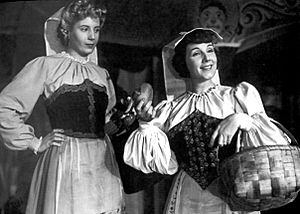
Life in Buenos Aires was hard at first. The city was crowded because many people moved there during the Great Depression. On 28 March 1935, Eva made her first professional acting appearance. It was in a play called Mrs. Perez at the Comedias Theater.
In 1936, Eva toured with a theater group and worked as a model. She also acted in some small movies. In 1942, she found more stable work. A company hired her for a daily role in a radio drama called Muy Bien. This show was on Radio El Mundo, the biggest radio station in Argentina.
Later that year, she signed a five-year contract with Radio Belgrano. This gave her a role in a popular historical drama. She played famous women like Elizabeth I of England and Sarah Bernhardt. Eva Duarte eventually became a co-owner of the radio company. By 1943, she was one of the highest-paid radio actresses in the country. She also had a short film career, but her movies were not very successful.
Her success in radio and film brought her financial stability. In 1942, she moved into a nice apartment in the Recoleta neighborhood. The next year, Eva began her political career. She helped start the Argentine Radio Syndicate (ARA).
Eva and Juan Perón

On 15 January 1944, a big earthquake hit San Juan, Argentina. It killed thousands of people. Juan Perón, who was the Secretary of Labour, started a fund to help the victims. He planned a fundraiser called an "artistic festival." He invited radio and film actors to join.
After a week of fundraising, everyone met at a big event. It was held at Luna Park Stadium in Buenos Aires. This is where Eva Duarte first met Colonel Juan Perón on 22 January 1944. Eva quickly became his girlfriend. She called that day her "marvelous day."
Before meeting Perón, Eva Duarte was not interested in politics. She listened and learned from him and his friends. Juan Perón later said he taught Eva everything. He wanted her to become like a "second self" to him. He was 48 and she was 24 when they met. He was open to her help in his political career.
In May 1944, a new rule said that broadcast performers had to form a union. This union would be the only one allowed in Argentina. Soon after, Eva Duarte was elected its president. Juan Perón had suggested forming the union. Other performers likely thought it was smart to elect his girlfriend.
After becoming union president, Eva Duarte started a daily radio show. It was called Toward a Better Future. The show told stories about Juan Perón's achievements. Sometimes, Perón's own speeches were played. Eva spoke in a simple way, like a regular woman. She wanted listeners to believe in Juan Perón as she did.
Rise to Power
Juan Perón's Arrest
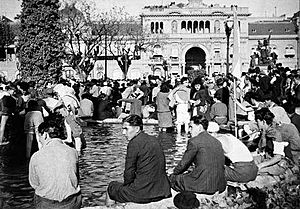
By early 1945, a group of Army officers, called the GOU (United Officers' Group), had a lot of power. President Pedro Pablo Ramírez worried about Juan Perón's growing influence. On 24 February 1944, Ramírez resigned. Edelmiro Julián Farrell, a friend of Perón, became president. Juan Perón returned to his job as Labor Minister. He was then the most powerful man in the government.
On 9 October 1945, Juan Perón was arrested. His opponents in the government feared he would try to take over. He had strong support from unionized workers.
Six days later, a huge crowd gathered. Between 250,000 and 350,000 people stood in front of the Casa Rosada. This is Argentina's government house. They demanded Juan Perón's release. At 11 pm, Juan Perón appeared on the balcony. He spoke to the crowd. This moment was very powerful. It reminded people of past Argentine leaders.
After Perón won the 1946 elections, his government spread a story. It said Eva Perón went door-to-door to gather people for the protest. This story became popular in the musical Evita. However, historians say this is not true. At that time, Eva was just an actress. She had no political power with unions. She was not even very popular in the film and radio world. The large rally that freed Perón was organized by various unions, especially the CGT. This union was Perón's main support group.
On 18 October 1945, the day after his release, Perón married Eva. They had a quiet civil ceremony in Junín. A church wedding followed on 9 December 1945 in La Plata. To this day, 17 October is a holiday for the Justicialist Party. It is called Día de la Lealtad, or "Loyalty Day."
1946 Presidential Election
After being released from prison, Juan Perón decided to run for president. He won the election by a large margin. Eva worked very hard to help her husband's campaign in 1946. She used her weekly radio show to give strong speeches. She used simple, popular language. She urged poor people to support Perón's movement.
European Tour

In 1947, Eva went on a famous "Rainbow Tour" of Europe. She met many important leaders, like Francisco Franco and Pope Pius XII. The trip started because the Spanish leader invited Juan Perón. Eva decided to go if Juan Perón would not. Argentina had just started to improve its relations with other countries. So, visiting Franco, who was an authoritarian leader, was not ideal.
Advisers decided Eva should visit other European countries too. This would show her support was not only for Franco's Spain. The tour was presented as a "goodwill" trip, not a political one.
Eva was welcomed warmly in Spain. She visited the tombs of Spanish monarchs. During her visit, Eva gave 100-peseta notes to many poor children. She also received a high award from the Spanish government.
Next, Eva visited Rome. The welcome there was not as warm. Pope Pius XII did not give her a special award. But she was given the same amount of time usually given to queens. She also received a rosary.
Her next stop was France. She met with Charles de Gaulle. She promised France two shipments of wheat.
While in France, Eva learned that King George VI would not meet her in Britain. Eva felt this was a rejection. She canceled her trip to the United Kingdom. She said "exhaustion" was the reason.

Eva also visited Switzerland. This part of the trip was difficult. Someone threw stones at her car, breaking the windshield. Later, protesters threw tomatoes at her. The tomatoes hit the Foreign Minister and splattered on Eva's dress. After these events, Eva ended her two-month tour and returned to Argentina.
Some people thought the real reason for the tour was to put money in a Swiss bank account. However, this was unlikely. Such tours were common, and there were easier ways to deposit money.
During her European tour, Eva Perón was on the cover of Time magazine. The cover called her "Eva Perón: Between two worlds, an Argentine rainbow." This was the only time a South American first lady appeared alone on the cover. The article also mentioned that Eva was born outside of marriage. Because of this, Time magazine was banned in Argentina for several months.
After returning to Argentina, Evita changed her style. She no longer wore fancy hairstyles or elaborate dresses. Her hair became a more subdued blonde, pulled back into a braided chignon. Her clothes became more refined. She started wearing simpler, fashionable Paris couture designs. She especially liked Christian Dior and Cartier jewels. To appear more serious, Eva began wearing conservative but stylish suits. These were also made by Dior and other Paris fashion houses.
Helping People and Women's Rights
Eva Perón Foundation
Before Juan Perón became president, a group of wealthy women called the Sociedad de Beneficencia handled most charity work in Buenos Aires. It was a tradition for the First Lady of Argentina to be the president of this charity. But the ladies of the Sociedad did not approve of Eva Perón. They disliked her poor background and acting career. They worried she would be a bad example. So, they did not offer her the presidency.
Some say Eva Perón then cut off the government money for the Sociedad. This is debated. But the money that used to go to the Sociedad now went to Eva's own foundation. The Eva Perón Foundation started with 10,000 pesos from Eva herself.
Some early biographies claimed the foundation's records were not kept. They suggested it was a way to hide government money. However, other historians say records were kept. They explain the foundation started to help the poor Eva saw every day. It also aimed to improve social services in Argentina. The foundation received donations from unions and businesses. It also got money from lottery tickets, movie tickets, casinos, and horse races. Some businesses were pressured to donate.
Within a few years, the foundation had a lot of money and goods. It employed 14,000 workers. It gave out many shoes, sewing machines, and cooking pots each year. The foundation also offered scholarships. It built homes, hospitals, and other helpful places. Eva oversaw every part of the foundation. It even built entire communities, like Evita City. Thanks to the foundation, healthcare in Argentina became more equal for everyone.
Towards the end of her life, Eva worked very long hours for her foundation. She often worked 20 to 22 hours a day. She ignored her husband's requests to rest. The more she worked with the poor, the more upset she became about poverty. She felt she was on a mission to fight poverty and social problems.
Female Peronist Party and Women's Vote
Eva Perón is often given credit for helping Argentine women get the right to vote. She spoke on the radio and wrote articles supporting women's suffrage. She asked men to support women's right to vote. However, the power to grant voting rights was not hers alone. She supported a bill that was eventually dropped.
A new bill for women's suffrage was introduced. The Senate of Argentina approved it on 21 August 1946. The House of Representatives approved it on 9 September 1947. This law, Law 13,010, gave equal political rights to men and women. It established universal suffrage in Argentina. The law was approved by everyone. In a public ceremony, Juan Perón signed the law. He then handed it to Eva, making it symbolically hers.
Eva Perón then created the Female Peronist Party. This was the first large political party for women in Argentina. By 1951, the party had 500,000 members. It had 3,600 offices across the country. Eva Perón did not call herself a feminist. But she greatly impacted women's political lives. Thousands of women who had never been involved in politics joined because of her. They were the first women active in Argentine politics. Women's right to vote and the Female Peronist Party helped Juan Perón win a large majority (63 percent) in the 1951 presidential elections.
1952 Presidential Election
Vice-Presidential Nomination
In 1951, Juan Perón chose Eva to be his candidate for vice-president. Some of Perón's more traditional allies did not like this idea. They did not want Eva to become president if Juan Perón died.
Eva was extremely popular, especially among working-class women. The strong support she received surprised even Juan Perón. It showed him that Eva was as important to the Peronist party as he was.
On 22 August 1951, labor unions held a huge rally. They called it the "Cabildo Abierto." This name referred to the first local government in 1810. The Peróns spoke to the crowd from a large platform. It was set up on Avenida 9 de Julio, near the Casa Rosada. Two large portraits of Eva and Juan Perón were above them. Some say this was the biggest public show of support for a female political figure ever.
Eva decided not to run for vice-president. She said her only goal was to help her husband. She wanted to bring the "hopes and dreams of the people to the president." She said she would turn those hopes and dreams into "glorious reality." In Peronist history, this event is called "The Renunciation." It shows Eva as a selfless woman.
Re-election and Spiritual Leader
On 7 May 1952, Eva's 33rd birthday, her husband gave her a special title. She was named "Spiritual Leader of the Nation."
On 4 June 1952, Eva rode with Juan Perón in a parade. It celebrated his re-election as President. By this time, Eva was very ill. She could not stand without help. She wore a special frame under her fur coat to help her stand. She took a lot of pain medicine before the parade.
Death and Aftermath
Declining Health
On 9 January 1950, Eva fainted in public. She had surgery three days later. It was reported that she had an appendectomy. But she actually had advanced cancer. She continued to faint through 1951. By 1951, her health was clearly getting worse. Juan knew she was very ill, even though he did not tell her the diagnosis. This made her vice-presidency bid impossible.
A few months after "the Renunciation," Eva had a secret surgery. An American surgeon tried to remove the tumor. In 2011, a Yale neurosurgeon studied Eva's X-rays. He suggested she might have had a brain surgery. This was possibly done to ease her pain and anxiety.
Eva's cancer had spread quickly despite the surgery. She was the first Argentine to receive chemotherapy. This was a new treatment at the time. She became very thin. By June 1952, she weighed only 36 kilograms (79 pounds).
Death and Mourning
Eva Perón died at 8:25 p.m. on Saturday, 26 July 1952. Radio broadcasts across the country were interrupted. They announced that "Mrs. Eva Perón, Spiritual Leader of the Nation, died."
Immediately after her death, the government stopped all official activities for several days. All flags were flown at half-mast for 10 days. Businesses closed. Movies stopped, and people left restaurants. The public grief was immense. A huge crowd gathered outside the presidential residence where Eva died. Streets were blocked for many blocks.
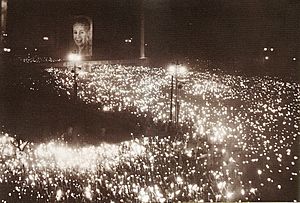
The morning after her death, Eva's body was moved. It went to the Ministry of Labour Building. Eight people were crushed to death in the crowd. In the next 24 hours, over 2,000 people were treated in hospitals for injuries. Thousands more were treated on the spot. For two weeks, lines stretched for many city blocks. Mourners waited hours to see Eva's body.
The streets of Buenos Aires were filled with flowers. Within a day, all flower shops in Buenos Aires ran out. Flowers were brought in from all over the country and even from Chile. Even though Eva Perón never held a political office, she received a state funeral. This is usually for a head of state. She also had a full Roman Catholic Requiem Mass.
On Saturday, 9 August, her body was moved to the Congress Building. There was another day of public viewing. A memorial service was held for the entire Argentine legislature. The next day, after a final Mass, her coffin was placed on a gun carriage. It was pulled by CGT officials. Juan Perón, his cabinet, Eva's family, and party members followed. Flowers were thrown from balconies.
Some reporters saw the mourning as real. Others thought it was a show put on by the Peronist government. Time magazine reported that the government made people observe five minutes of mourning daily.
When she died, the public was told Eva was only 30. This was because Eva had changed her birth certificate in 1946. She made herself three years younger. She also changed it to say she was born to married parents.
Memorial and Burial
After Eva's death, plans were made for a memorial. It was to be a huge statue of a man, representing the descamisados. It would be larger than the Statue of Liberty. Eva's body was to be kept in the base of the monument for public viewing. While the monument was being built, Eva's embalmed body was displayed in her old office. It stayed there for almost two years.
Before the monument was finished, Juan Perón was overthrown. A military coup, called the Revolución Libertadora, happened in 1955. Perón quickly left the country. He could not arrange to protect Eva's body.
The new military government took Eva's body. Its location was a mystery for 16 years. From 1955 to 1971, the military government banned Peronism. In 1971, the military found Eva's body. It was buried in a crypt in Milan, Italy, under a different name.
Final Resting Place

In 1971, Eva's body was dug up and flown to Spain. Juan Perón kept the body in his home. In 1973, Juan Perón returned to Argentina. He became president for the third time. His third wife, Isabel Perón, became vice-president. When Juan Perón died in 1974, Isabel became president. She had Eva Perón's body returned to Argentina. It was displayed next to her husband's body. Later, Eva's body was buried in the Duarte family tomb. This is in La Recoleta Cemetery, Buenos Aires.
Later Argentine governments made Eva Perón's tomb very secure. The tomb has a marble floor with a trapdoor. This leads to a compartment with two coffins. Below that is another trapdoor and another compartment. Eva Perón's coffin rests there.
Eva's Legacy
Impact in Argentina
Eva Perón's appeal and success are linked to Latin American ideas of leadership. Historian Hubert Herring called her "perhaps the shrewdest woman yet to appear in public life in Latin America."
Tomás Eloy Martínez described Eva Perón as "the Cinderella of the tango." He also called her the "Sleeping Beauty of Latin America."
The anniversary of Eva Perón's death is still important to many Argentines. Eva Perón has been featured on Argentine coins. A type of Argentine money was even named "Evitas." Ciudad Evita (Evita City) was built by the Eva Perón Foundation in 1947. It is just outside Buenos Aires.
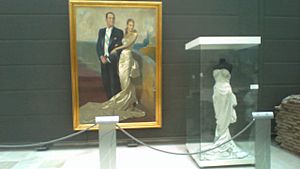
Cristina Fernández de Kirchner was the first elected female president in Argentina. She is a Peronist. She has sometimes been called "The New Evita." Kirchner says she does not want to compare herself to Eva. She believes Eva was unique in Argentine history. Kirchner also says women of her generation owe a lot to Eva. She gave them an example of passion and strength.
On 26 July 2002, a museum opened in Eva's honor. It is called Museo Evita. The museum was created by her great-niece, Cristina Alvarez Rodriguez. It displays many of Eva Perón's clothes and portraits. It has become a popular place for tourists. The museum is in a building that was once used by the Eva Perón Foundation.
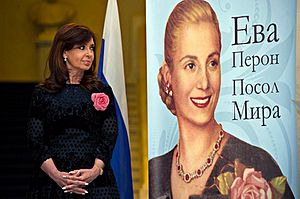
In 2011, two huge murals of Eva were put on buildings. They are on the Ministry of Social Development in Buenos Aires. Argentine artist Alejandro Marmo painted them. On 26 July 2012, new 100-peso notes were issued. This was to mark 60 years since Eva's death. The image on the notes is based on a 1952 design.
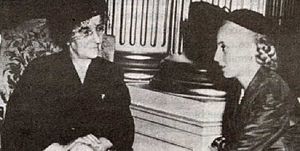
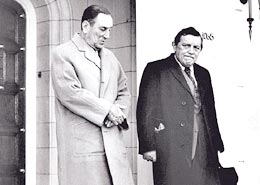
International Popular Culture
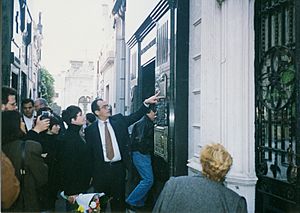
By the late 1900s, Eva Perón was the subject of many articles, books, plays, and musicals. The most famous is the musical Evita. It started as a concept album in 1976 by Andrew Lloyd Webber and Tim Rice. Julie Covington sang the main role. Later, Elaine Paige played the role in the London stage production. She won an award for Best Performance in a Musical. In 1980, Patti LuPone won a Tony Award for her role in the Broadway production. The Broadway show also won Best Musical. It is said that the musical has been performed on every continent except Antarctica. It has made over $2 billion.
The musical was considered for a movie as early as 1978. After almost 20 years, Madonna was cast as Eva in the 1996 film version. She won a Golden Globe Award for Best Actress. In response to the American film, an Argentine film company released Eva Perón: The True Story. This movie aimed to show a more accurate picture of Eva's life. Actress Esther Goris played Eva. This movie was submitted for an Oscar but was not nominated.
Some say Eva is a perfect popular culture icon for today. Her career showed what would become common later. In her time, it was shocking for an entertainer to be in politics. Her critics said she turned politics into show business. But by the late 1900s, people were very interested in celebrities. Public political life became less important. In this way, Eva was ahead of her time. Her story is also appealing because it is a classic rags to riches story.
Titles and Honours
Eva Perón appears on the 100 peso note. It was first issued in 2012.
Honours
National Honours
 Argentina: Grand Cross with Collar of the Order of the Liberator General San Martín
Argentina: Grand Cross with Collar of the Order of the Liberator General San Martín Argentina: Grand Cross of Honour of the Argentine Red Cross
Argentina: Grand Cross of Honour of the Argentine Red Cross
Foreign Honours
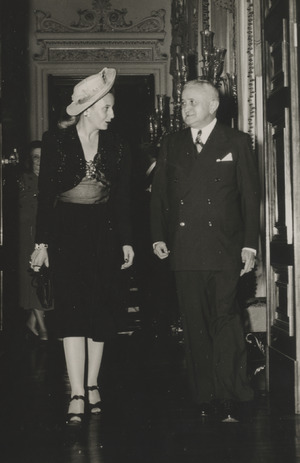
 Bolivia: Grand Cross of the Order of the Condor of the Andes
Bolivia: Grand Cross of the Order of the Condor of the Andes Brazil: Grand Cross of the Order of the Southern Cross
Brazil: Grand Cross of the Order of the Southern Cross Colombia: Grand Cross of the Order of Boyaca, Special Class
Colombia: Grand Cross of the Order of Boyaca, Special Class Netherlands: Dame Grand Cross of the Order of Orange-Nassau
Netherlands: Dame Grand Cross of the Order of Orange-Nassau Spain: Dame Grand Cross of the Order of Isabella the Catholic
Spain: Dame Grand Cross of the Order of Isabella the Catholic Sovereign Military Order of Malta: Dame Grand Cross of Sovereign Military Order of Malta
Sovereign Military Order of Malta: Dame Grand Cross of Sovereign Military Order of Malta Mexico: Grand Cross of the Order of the Aztec Eagle
Mexico: Grand Cross of the Order of the Aztec Eagle Syria: Grand Cross of the Order of Omeyades
Syria: Grand Cross of the Order of Omeyades Ecuador: Grand Cross of the Order of Merit and the Ecuadorian Red Cross
Ecuador: Grand Cross of the Order of Merit and the Ecuadorian Red Cross Haiti: Grand Cross of the Order of Honour and Merit
Haiti: Grand Cross of the Order of Honour and Merit Perú: Grand Cross of the Order of the Sun of Peru
Perú: Grand Cross of the Order of the Sun of Peru Paraguay:Grand Cross of the Merit of Paraguay
Paraguay:Grand Cross of the Merit of Paraguay
See also
 In Spanish: Eva Perón para niños
In Spanish: Eva Perón para niños



